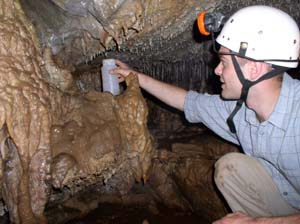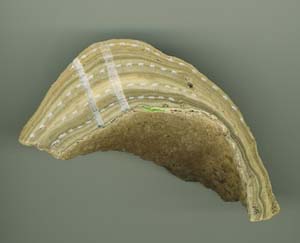Secret History of Stalagmites

Lancaster University has appointed a new researcher who is exploring the environmental secrets locked up in stalagmites.
Stalagmites, found in caves, take hundreds, sometimes thousands of years to form. They grow layer upon layer from the re-precipitation of calcium carbonate, which filters down into the cave in rainwater from the earth’s surface.
Using samples of stalagmites from Italy, Ethiopia, Australia and the UK Geochemist Dr Peter Wynn is investigating how much information can be extracted from each of these layers and how this new information can add to our understanding of environmental change.
Rain water entering the cave environment as drip water carries a chemical composition which reflects the environment through which it has travelled. This becomes locked up in the stalagmites, providing an environmental record of atmospheric pollution, temperature and vegetation history. Current research is involving the extraction of organic matter from the stalagmites to identify ‘markers’ of human activity.

Dr Wynn said: “If you slice a stalagmite in half it is very much like looking at rings of a tree, each layer representing roughly one annual cycle. If we can extract organic matter from these layers it could be possible to build up a detailed record of human activity in the immediate area surrounding the cave, going back hundreds, in some cases thousands of years. It may be possible to find evidence for the frequency bush fire events occurring in Australia, human occupation of Alpine cave sites and the severity of pollution released into the atmosphere during the industrial period.”
“Stalagmites alone can’t tell us everything we need to know about the changes in the environment but they can add another layer of information in addition to that provided by ice cores, tree rings and lake sediments. They record environmental events on a local scale over a variety of time frames.”
Dr Wynn is based in Lancaster University’s Environment Centre in the Department of Geography. Before joining LancasterUniversity, Dr Whnn was at the University of Birmingham doing Post Doctoral Research into stalagmites as palaeoclimatic indicators. He completed a PhD on the isotopic biogeochemistry of glacial environments at the University of Sheffield.